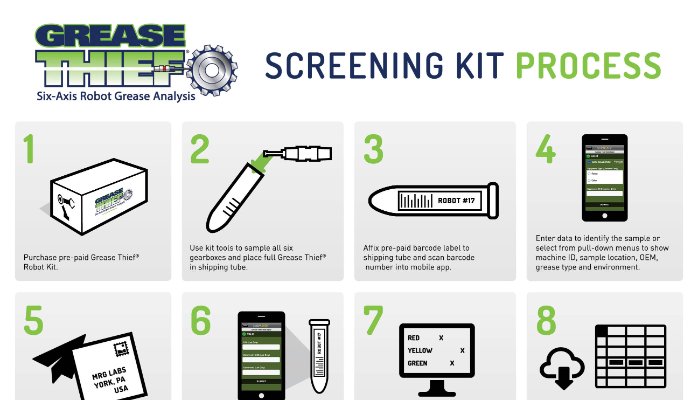Robotic Sampling
The robots are coming? Nay, they are already here. A PriceWaterhouseCoopers report cited over 120,000 industrial robots were shipped in 2013 alone, and the automotive and parts industries accounted for nearly 70% of those orders in North America. If you own a car, chances are its parts or the car itself was welded, painted and assembled by advanced 6-axis robots, much as we see on car commercials with increasing frequency. But how do the manufacturers keep this new workforce in good working order, and what happens when they unexpectedly fail to show up for work?
Traditional machinery monitoring technologies to ensure reliability include vibration analysis, infrared thermography, and oil analysis. And while infrared monitoring can be performed at a distance while robots are running, vibration analysis has limited effectiveness due to the severe movements of most programmed robots. While some robots do have oil lubricated gearboxes, the majority of the robotic workhorses in auto manufacturing are grease lubricated. It is in that grease which lies a picture of the health of the critical robot joint health.
Grease is the lifeblood of a robot, and in the same way we use a blood test to proactively monitor human health and prescribe lower risk corrective actions, the same strategy can now be taken with robots. Made possible by the development of a unique sampling and analysis tool, the Grease Thief®. An ASTM compliant device, the Grease Thief has been included in a kit designed to obtain representative samples from all robot gear joints with a minimal amount of intrusion. Downtime is minimized, and the robot is restored to operating service in short-order, while the blood sample grease sample is sent off to the lab for analysis. How does this work? See in this video of a Fanuc industrial robot being sampled with the Grease Thief:
A screening test has recently been developed that has resulted in a price breakthough for robot grease analysis. By taking advantage of the Grease Thief’s unique geometry and optical characteristics, a two-part test can be performed that quantifies the ferrous debris content (wear particles) and the optical characteristics (color) of the grease. As the robot first begins to experience the effects of aging and hard use, its joints become arthritic. Yes, even an aging robotic workforce begins to show signs, and these signs are tiny particles of bearing and gear material that are effectively quantified by the Grease Thief screening test. At a glance, a large fleet of robots and their joints can be assessed, and those at greater risk for breakdown or malfunction are identified. The second test, grease colorimetry, monitors the health of the grease itself as it ages, and assesses the need for replacement and replenishment. The optical properties also allow early detection of mixing of greases with the incorrect product, and degradation of seals and other components within the gearbox housing, like the motors and seals. Together, these two tests allow robot operators to care for their fleet of workers, and find those in need of proactive care, before they (the robots) decide on their own to take a break at the most inopportune time.
Costs of operating and maintaining such advanced robots are not trivial. The grease alone can cost hundreds of dollars for a single robot replenishment, and the downtime to perform the flushing, purging and restoration of the robot can be a significant drain on manpower drain and uptime. A typical grease changeout consists of Lock-out/Tag-out of the robot, pumping an entire container of the expensive grease into each of the six gearboxes, extended operation of the robot with the plugs removed to purge the excess grease, cleanup of the purged grease that inevitably ends up on the outside of the robot, floor, and surrounding equipment, replacement of the drain plugs, reprogramming and testing, and return to service. This entire operation can take over an hour, meaning potential downtime and significant maintenance resources.
Compare the normal annual grease changeout to the Grease Thief sampling and screening: the robot is tagged out in a position that allows the samplers to access the used grease, drains or access fittings are removed, and the grease is extracted with the tools found in the Grease Thief Robot Kit. There is no purging of grease required, so the plugs are replaced, and the robot is restored to service in minutes. The robot is back to work, while its sample is off to the lab for analysis. How does this compare? With nearly an hour of downtime and maintenance time saved, and up to $500 of grease costs typically avoided, the Grease Thief Screening process can save up to $2500 per robot per year on maintenance costs, not even counting any avoided sudden failures that result in extended production downtime.
How can testing extend the life of grease? Most robot operating manuals dictate that grease must be flushed and replaced annually or more often. This direction is given without consideration to the operating cycles, local temperatures (some robots are near furnaces, others in air conditioned spaces), load, moment arm and acceleration (wildly varying the stress placed on the gears and grease) or the ambient environment (such as dust, paint, chemicals, etc.). A Preventive Maintenance (PM) task whose frequency does not reflect changing variables will inevitably be either overly conservative, or ineffective. Only by adopting Condition Based Maintenance (CBM) approach using diagnostic monitoring, can the maintenance intervals be optimized, and the maintenance resources used efficiently.
Take the next step to improve robot reliability and reduce robot maintenance costs by initiating a Robot Healthcare Plan, which begins with the blood test for robots, the Grease Thief. Kits are available at GreaseThief.com, and assistance is available at MRG Labs (1-717-843-8884) and other labs around the world using the Grease Thief technology for analysis.

